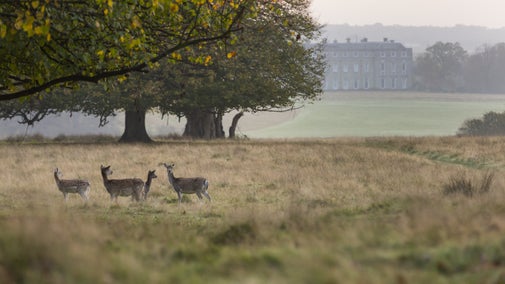
Discover more at Petworth
Find out when Petworth House and Park is open, how to get here, the things to see and do and more.

The garden at Petworth House was designed by Lancelot ‘Capability’ Brown during the 18th century. Brown removed the formal features that had previously existed here and introduced colourful informal planting, winding paths and impressive monuments with views over the surrounding landscape. Open all year round, you're welcome to bring your dog to enjoy the garden with you.
The Pleasure Garden lies between the car park and the house. As you make your way through the garden to the courtyard you can enter the house just as guests of the past would have done.
Once you have explored the garden at your leisure you can enter the Deer Park through the iron Tijou Gate beside the house. Please take note of the closing time of the gate if you've parked in the main visitor car park for Petworth House, as these gates are the only way back.
Constructed in 1766 at the suggestion of Brown, the Rotunda is similar in style to the Temple of Vesta in Trivoli, Italy. When seen from below, the Rotunda symbolises the difficult and steep path to fame. Designed as one of the two focal points in the Pleasure Garden, it offers panoramic views of the surrounding countryside.
The temple was relocated from the Deer Park to the garden by Brown in the 1750s before being moved to its current location in 1875. Based on the Doric temples of Greece it is designed to evoke dignity, nobility and antiquity. Today it houses a memorial to Henry Scawen Wyndham (1915-1942), who died in action at El Alamein during the Second World War.

Morning sunlight peeks through the branches of the trees in the Pleasure Garden as the leaves unfurl on the deciduous woodland walk. Bright yellow daffodils fill the grounds leading up to the Ionic Rotunda. By April this golden display begins to be replaced with the violet hue of bluebells as they bloom across the garden, along with the unfurling of white and pink blossom on a variety of trees.
The garden here was historically known as the Pleasure Grounds. This was a popular garden style during the Georgian period where the family and their guests could walk privately or socialise, perhaps over tea or a game of croquet.
During this period, plant collecting in the Americas was becoming popular and pleasure gardens around the country became areas to showcase plants brought to Georgian England from overseas. Alongside being a supporter of the arts, the 3rd Earl of Egremont here at Petworth was a patron of plant collectors and he used the Pleasure Garden to display his own collection of North American trees and shrubs.

Find out when Petworth House and Park is open, how to get here, the things to see and do and more.

The ‘Capability’ Brown designed parkland at Petworth House has much to explore. Discover things to do and what to keep an eye out for when you visit.

From the medieval interiors of the chapel to the rooms of the historic kitchens, find out what you can see on a visit to the house at Petworth.

Petworth is a two pawprint rated place. Find out about bringing your dog to Petworth to walk through the Deer Park or soak up the peace and beauty of the Pleasure Garden.

With plenty of space to run, jump and play there's lots to fun for families to have at Petworth.

Brown designed landscapes that fitted in seamlessly with the surrounding countryside. So how do you spot the designs of one of the greatest gardeners of all time?

From 18th-century water gardens and Arts and Crafts landscapes to intimate woodland gardens, there are so many places to discover.

Discover our gardeners’ top tips so you can make the most of your garden, plot or window box.

Beautiful gardens are found all over Sussex. The romantic gardens at Nymans and Bateman's; and Capability Brown landscapes at Sheffield Park and Petworth are all yours to explore.